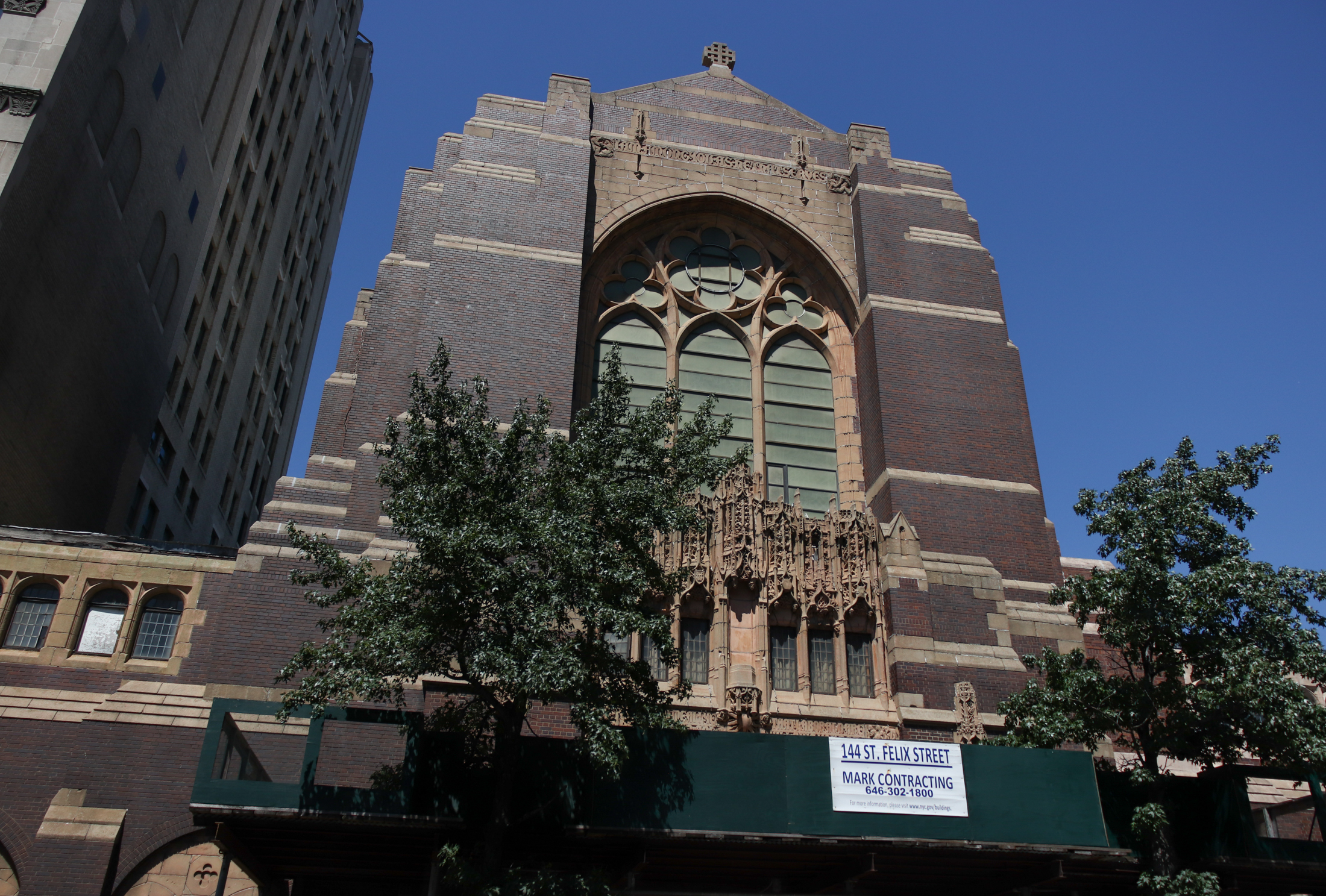Building of the Day: 40 Greene Avenue
Brooklyn, one building at a time. Name: Paul Robeson Theater, formerly St. Casmir Catholic Church, originally Church of the Redeemer Address: 40 Greene Avenue Cross Streets: Carlton and Adelphi Streets Neighborhood: Fort Greene Year Built: 1864, with major alterations in 1890 Architectural Style: Rundbogenstil Romanesque Revival Architect: Rembrandt Lockwood, with 1890 alterations by Frederick Weber…

Brooklyn, one building at a time.
Name: Paul Robeson Theater, formerly St. Casmir Catholic Church, originally Church of the Redeemer
Address: 40 Greene Avenue
Cross Streets: Carlton and Adelphi Streets
Neighborhood: Fort Greene
Year Built: 1864, with major alterations in 1890
Architectural Style: Rundbogenstil Romanesque Revival
Architect: Rembrandt Lockwood, with 1890 alterations by Frederick Weber
Landmarked: Yes, recently individually landmarked (2011)
The story: The weathered pressed metal-clad spire and parapet of this former church rises above this part of Fort Greene. Its patina and general appearance has always made me wonder about its origins, and although there were tidbits of information, it wasn’t until it was designated as a landmark this year, that the full story of this building was revealed. And an interesting history it has, indeed, with various faiths using it over the years, an architect with an almost fictional Victorian Romantic name, and its more recent history as a theater; an important part of the African-American heritage of Brooklyn.
If Rembrandt Lockwood didn’t make up his name, then his parents knew he would be a painter and artiste. What else could he have possibly done? He doesn’t leave a lot of information behind him, but we know he was born in New York in 1841, studied painting for a time in Munich, and then returned to the United States, moved to Newark, and spent the next ten years of his life working on an enormous mural of the Last Judgment. Apparently, that was not universally well received, so he changed his career, moved to Newburgh, NY, and became an architect. He specialized in churches and ecclesiastical buildings, and in 1863, moved to NYC, where he practiced until at least 1876. This church was designed after that move to the city.
It’s in the Rundbogenstil, or round arch, substyle of Romanesque Revival architecture, a style often referred to as “German Romanesque Revival”. He probably picked up the influence in his time in Germany. It was the favorite style of German-American architect Theobald Engelhardt. Rundbogenstil uses simple round arches, and is spare in its decoration. In 1890, the church was “modernized” by architect Frederick Weber, who added the metal cladding, the steeple, louvers, and other details, some of which are long gone. In the 1950’s, the original stained glass windows, which were opalescent glass, were replaced by figural stained glass.
Lockwood designed the church for the Fourth Universalist Society of Brooklyn, which named it the Church of the Redeemer. The Universalists were a huge denomination in the 19th century, the 6th largest in the country. They eventually sold the building to Temple Israel in 1870. Since the Universalists shunned fancy churches with lots of religious symbolism, the temple was able to move right it, and they stayed until 1890, when Bishop John Laughlin, the first Catholic bishop of Brooklyn, bought the building for the Polish congregation of St. Casmir. It was at this time that the church underwent the expansion and renovation that added the fancier details we see today, those done by Frederick Weber. The church became a flagship church for Brooklyn’s Polish Catholic community, and remained so until 1980, when failing attendance caused it to merge with another parish. The dioceses then put the building on the market.
That year, the church building was purchased by Dr. Josephine English, the first African-American licensed obstetrician/gynecologist in New York State. This powerhouse of a woman had previously founded the Adelphi Medical Center at the corner of Greene Avenue and Adelphi Street, in the former Adelphi Hospital. She would go on to establish a senior citizen center and in the next ten years, a day center, summer day camp, and after-school center for the youth of the neighborhood. She bought St. Casmir’s in 1980, during the midst of all this other work, in order to start a theater, one she named after the famous black actor and activist, Paul Robeson. She felt that this theater could enrich the lives of the people in the neighborhood and bring racial and neighborhood pride to its residents. That theater has been active for the last thirty years.
We need more people like Dr. English, and her name, her career, and accomplishments should be much better known. Hopefully, the landmarking of the building and conversations like this will help in that cause. GMAP











Check your spelling of first Catholic Bishop of Brooklyn. It should be Bishop Loughlin, same as the school located down the street which was named after him.
This looks to me like it was supposed to have been built in Salt Lake City. It is such an unusual design for a New York church. Slightly Mormonic with a dash of the Kremlin.
Very interesting visually.
Pretty seriously awful piece of architecture. c